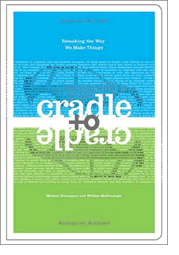
A couple of days ago, Bruce Nussbaum, BusinessWeek’s innovation and design guru, posted on his blog that “We now have two approaches to sustainability—live light on the land and cut back consumption vs. live like the crazy consumer that you are but use different chemistry that recycles, reuses and reinvents stuff.”
“Hair-shirt sustainability vs. Go-Go growth sustainability,” he wrote. “Colin Beavan—No Impact Man meet Bill McDonough, Cradle to Cradle man.”
Since you’re reading this, you presumably know me, No Impact Man, and what I’m about. In case you don’t, I am trying, with my wife, child and dog, to live in the middle of New York City while creating as low as possible an environmental impact–largely by reduced consumption.
And in case you aren’t familiar with Bill McDonough (that’s the cover of his book on the right), he is a design genius who envisions a world where products can be disassembled so that components and materials can be reclaimed and used to provide for the next cycle of manufacture. McDonough’s plan is for a birth, death and reuse of materials in industry that mimics that of nature. He calls it Cradle to Cradle.
But the way I see it, the No Impact and the Cradle to Cradle philosophies are not at odds. There is no fight. They are two facets of the same general strategy–to treat the planet more gently.
Sadly though, most products are not yet designed according to McDonough’s Cradle to Cradle model of sustainability. Rather than acting as nutrients that return safely to the manufacturing cycle, items that have outlived their usefulness become toxins that are buried in the earth, dumped in the water or vaporized in the air. In part, this is why, for now, I choose the No Impact method of treating the world more gently–because I’m frustrated that big business is moving so slowly at providing sustainable, Cradle to Cradle products.
Meanwhile, a third thinker, Seth Godin, the marketing wiz, discussing the No Impact project on his blog, writes:
“The richest and best-educated people in our economy are shifting, and pretty quickly. They’re just as willing to spend money as they always were, but now it’s not focused on fancy organic stuff at the Whole Foods Market or giant bulletproof cars from Germany or private jet travel. Instead, the market is trying as hard as it can to spend time and money without leaving much of a trace.”
“Zero is the new black,” Godin says. What that means is that big business will have to take notice of people like me who are willing to forgo products if buying and using them means harming the planet. My refusing to consume unsustainably as part of No Impact is one tiny market signal that, when added with many others, tells big business that if it wants us to buy, it’s going to have to manufacture safely, the way McDonough suggests.
So me and Bill McDonough don’t have anything to fight about. One major reason for a reduced consumption project like No Impact Man is that industry is not adopting ideas like McDonough’s fast enough. With enough No Impact style consumer protest, business will have to pay attention. It will have to work a lot faster to make its products sustainable. Maybe, then, one day, the whole idea of having to consume less to help the planet will become less urgent.
This post also appears in my Green Parenting column for Time Out New York Kids, appearing every Wednesday. For resources on eco-friendly stores and restaurants, or simply to plan a weekend outing, visit them at tonykids.com.